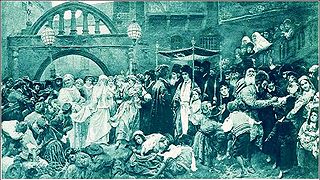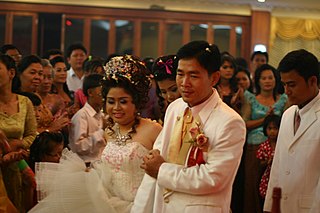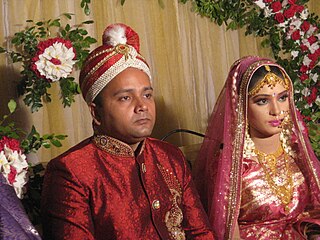
A wedding is a ceremony where two or more people are united in marriage. Wedding traditions and customs vary greatly between cultures, ethnic groups, religions, countries, and social classes. Most wedding ceremonies involve an exchange of marriage vows by a couple, presentation of a gift, and a public proclamation of marriage by an authority figure or celebrant. Special wedding garments are often worn, and the ceremony is sometimes followed by a wedding reception. Music, poetry, prayers or readings from religious texts or literature are also commonly incorporated into the ceremony, as well as superstitious customs originating in Ancient Rome.

An engagement or betrothal is the relationship between two people who want to get married, and also the period of time between a marriage proposal and a marriage. During this period, a couple is said to be betrothed,intended, affianced, engaged to be married, or simply engaged. Future brides and grooms may be called the betrothed, a wife-to-be or husband-to-be, fiancée or fiancé, respectively. The duration of the courtship varies vastly, and is largely dependent on cultural norms or upon the agreement of the parties involved.

In Islam, a mahr is an arbitrary payment, in the form of money or possessions paid by the groom, to the bride at the time of marriage. While the mahr is often money, it can also be anything agreed upon by the bride such as jewelry, home goods, furniture, a dwelling or some land. Mahr is typically specified in the marriage contract signed during an Islamic marriage.

In Islam, marriage is a legal contract between a man and a woman. Both the groom and the bride are to consent to the marriage of their own free wills. A formal, binding contract - verbal or on paper - is considered integral to a religiously valid Islamic marriage, and outlines the rights and responsibilities of the groom and bride. There must be two Muslim witnesses of the marriage contract. Divorce in Islam can take a variety of forms, some executed by a husband personally and some executed by a religious court on behalf of a plaintiff wife who is successful in her legal divorce petition for valid cause.

Traditional Chinese marriage, as opposed to marriage in modern China, is a ceremonial ritual within Chinese societies that involve a union between spouses, sometimes established by pre-arrangement between families. Within Chinese culture, romantic love and monogamy was the norm for most citizens. Wedding rituals and customs often varied by region because of China's extensive and rich history and because of the numerous different cultures and ethno-linguistic groups that have been subsumed into modern Chinese culture.

The Luo are an ethnic group in western Kenya, northern Uganda, and in Mara Region in northern Tanzania. They are part of a larger group of ethno-linguistically related Luo peoples who inhabit an area ranging from South Sudan, South-Western Ethiopia, Northern and Eastern Uganda, South-Western Kenya and North-Eastern Tanzania.
Lobola in Zulu, Swazi, Xhosa, Silozi and northern and southern Ndebele, and Mamalo in Tshivenda Language, sometimes referred to as "bride wealth" is property in cash or kind, which a prospective husband or head of his family undertakes to give to the head of a prospective wife’s family in gratitude of letting the husband marry their daughter.

A Jewish wedding is a wedding ceremony that follows Jewish laws and traditions.

The Hmong people are an ethnic group currently native to several countries, believed to have come from the Yangtze river basin area in southern China. The Hmong are known in China as the Miao which encompasses all the subgroups of Hmong. There is debate about usage of this term, especially amongst Hmong living in the West, as it is believed by some to be derogatory, although Hmong living in China still call themselves by this name. Throughout recorded history, the Hmong have remained identifiable as Hmong because they have maintained their own language, customs, and ways of life while adopting the ways of the country in which they live. In the 1960s and 1970s many Hmong were secretly recruited by the American CIA to fight against communism during the Vietnam War. After American armed forces pulled out of Vietnam, a communist regime took over in Laos, and ordered the prosecution and re-education of all those who had fought against its cause during the war. Whilst many Hmong are still left in Laos, Thailand, Vietnam, Myanmar, and China, since 1975 many Hmong have fled Laos in fear of persecution. Housed in Thai refugee camps during the 1980s, many have resettled in countries such as the United States, French Guiana, Australia, France, Germany, as well as some who have chosen to stay in Thailand in hope of returning to their own land. In the United States, new generations of Hmong are gradually assimilating into American society while being taught Hmong culture and history by their elders. Many fear that as the older generations pass on, the knowledge of the Hmong among Hmong-Americans will die as well.

Marriage in South Korea mirrors many of the practices and expectations of marriages in familiar to other societies, and as such, is constantly changing.

The Tripuri culture of North-East India has many distinctive features.

The traditional Vietnamese wedding is one of the most important ceremonies in Vietnamese culture, which is influenced by Confucian and Buddhist ideologies.
Iranian wedding, also known as Persian wedding, traditions go back to the Zoroastrianism, which was the religion of pre-Islamic Iran despite their local and regional variations. Though the concepts and theory of the marriage have been changed by Islamic traditions, the actual ceremonies have remained more or less the same as they were originally in the ancient Iranian culture. Although modern-day Iran is a multi-ethnic country, Iranian wedding traditions are observed by the majority of ethnic groups in Iran.

Marriage in Pakistan pertains to wedding traditions established and adhered by Pakistani men and women. Despite their local and regional variations, marriages in Pakistan generally follow Islamic marital jurisprudence. Culturally, marriages are not only seen as a union between a husband and a wife, but also an alliance between their respective families. These traditions extend to other countries around in the world where Overseas Pakistani communities exist.
Punjabi wedding traditions are a strong reflection of Punjabi culture with ritual, song, dance, food, and dress that have evolved over centuries.

Courtship, marriage, and divorce in Cambodia are important aspects of family life. Customs vary as between rural and urban areas, with many city dwellers being influenced by western ideas. The choice of a spouse is usually undertaken by the families of young men and women, sometimes with the help of a matchmaker. A man usually marries between the ages of nineteen and twenty-five and a girl between sixteen and twenty-two. After a spouse has been selected, a go-between discusses the proposal with the parents, who need to be satisfied that the right choice is being made for their offspring. Presents are exchanged, and in rural areas, a young man may have to vow to serve his new father-in-law for a while.

Muslim marriage and Islamic wedding customs are traditions and practices that relate to wedding ceremonies and marriage rituals prevailing within the Muslim world. Although Islamic marriage customs and relations vary depending on country of origin and government regulations, both Muslim men and women from around the world are guided by Islamic laws and practices specified in the Quran.
An Odia Hindu wedding, or bahaghara, is a wedding ceremony performed by Odia Hindu people in the Indian state of Odisha. There are subtle differences in the rites observed by different castes. In Odia marriage rituals the mother of the bridegroom does not take part in the ceremony. The Utkala Brahmins have their weddings only in the daytime, preferably at midday or in the morning, while the other caste weddings are done during the evening or night. There is the custom of sending betel nuts to family friends for inviting them to the marriage. The first invitation is sent to Jagannath as a respect to the lord. Marriages in Odisha are mostly fixed and arranged by the parents. Marriages for serving or capturing is not common. In the Odia community widow remarriage is allowed in some lower caste, in this case the younger brother is allowed to marry the deceased brother's wife. The marriage happens in three major rituals, Nirbandha, Bahaghara (wedding) and Chauthi/Chaturthi (consummation). A marriage is not considered complete or valid until consummation. These rituals are performed either at the Duara or Tola kanias house..

Bride price, bridewealth, or bride token, is money, property, or other form of wealth paid by a groom or his family to the family of the woman he will be married to or is just about to marry. Bride price can be compared to dowry, which is paid to the groom, or used by the bride to help establish the new household, and dower, which is property settled on the bride herself by the groom at the time of marriage. Some cultures may practice both dowry and bride price simultaneously. Many cultures practiced bride pricing prior to existing records.

Traditional Hajong marriage is a ceremonial ritual that involves a marriage established by pre-arrangement between families. Within Hajong culture, romantic love and widow re-marriage was allowed, and monogamy was the norm for the Hajong people.















